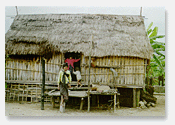Home » Ethnic People » Brau
The Brau People

The 1989 Vietnam census found there to be just 231 people belonging to the Brau tribe in Vietnam. Their main community is at Dak Me Village, situated on a plateau in the Ngoc Hoi District of Kon Tum Province. In addition, 14,000 Brau live in Cambodia and 13,000 in Laos. Small communities of Brau refugees also live in the United States and France.
In Vietnam, the Brau area is situated at the juncture where Vietnam, Laos and Cambodia meet. Brau villages are constructed in a circular formation around a communal house at the center. The Brau’s homes are built on stilts with sharply-angled two-sided roofs going all the way down to near the ground. The front ridge of the rood is decorated with sculptures in the form of a bird’s head or the sun, which are common totems among many Mon-Khmer-speaking people groups.
Until recently the Brau were semi-nomadic people, roaming the forests and clearing land so they could live there for a while before moving on. Today they are more settled. In addition to hunting and fishing, the Brau grow cassava, pumpkins, sugarcane, mustard and bananas. In the 3rd month of every year, they use axes and knives to clear the land.
The Brau plant seeds by inserting them into the soil in the 5th month. The men walk along making holes in the soil with a stick, while their wives follow, inserting the seeds in the holes. When the planting is completed the Brau hold a ritual to ask the spirits of the soil to bless the seeds and to ensure a successful crop. This dependence on the help of the spirit-world is essential for the Brau, as a poor harvest could mean famine for the entire community.
According to the centuries of tradition, the Brau file their teeth and have tattoos on their bodies and faces. The Brau are a somewhat primitive people. Both men and women usually go around naked from the waist up, except when they enter other towns to trade with the Lao, Vietnamese, Bana and Sedang. Brau women like to adorn themselves with large bamboo earrings, and several large chains around their arms, necks and ankles.
Despite the small size of their community in Vietnam, two separate classes exist among the Brau. The rich families possess most of the land and own the majority of cattle, copper pots and jewelry, which are considered the most valuable assets that a Brau can own. At least 90% of the Brau population belongs to the peasant class. They are menial labourers for the rich class; they live very basically, trying to survive from one rice harvest to the next.
After marriage, the husband is required to live with his wife’s family for an extended—often as long as four or five years. After that time he is allowed to take his family to his own home. A distinctive part of Brau culture is their deep love for music. A set of gongs, called chieng tha are considered extremely valuable and may sell for the equivalent of 30-50 water buffaloes. Brau girls like to play the klong put, an instrument built with several bamboo tubes. Air is forced into the tubes by clapping their hands in various ways over the different openings of bamboo. If a young Brau man wants to be considered an attractive partner to the girls, he must show his competence in playing these instruments.
Most Brau in Vietnam are animists. They consider Pay Xay the greatest and strongest spirit in the universe. They believe he created the heavens, earth, rivers, rain, wind, humans and animals. They also believe Pay Xay holds the power of death over all creation. In some ways, the Brau live in awe of this deity, in other ways they are afraid of him. It is likely the belief in a Creator, Pay Xay, may provide a cultural bridge for the Brau to better understand the Gospel.
The Brau also believe in and worship the forces of nature, including the “spirit of the sky” and the “spirit of the water”. They believe each individual also has a guardian spirit whose job is to protect them from all harm.

